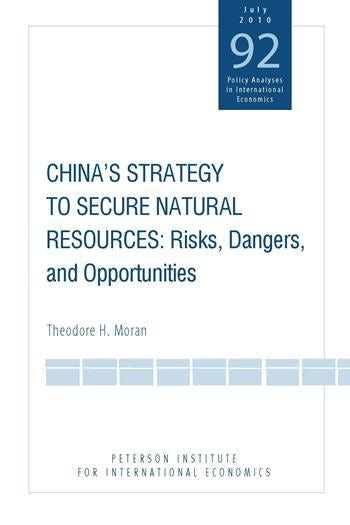The rapid emergence of China as a major industrial power poses a complex challenge for global resource markets. Backed by the Chinese government, Chinese companies have been acquiring equity stakes in natural resource companies, extending loans to mining and petroleum investors, and writing long-term procurement contracts for oil and minerals. These activities have aroused concern that China might be "locking up" natural resource supplies, gaining "preferential access" to available output, and extending "control" over the world's extractive industries. On the demand side, Chinese appetite for vast amounts of energy and minerals puts tremendous strain on the international supply system. On the supply side, Chinese efforts to procure raw materials can either exacerbate or help solve the problems of high demand.
Evidence from the 16 largest Chinese natural resource procurement arrangements shows that Chinese efforts—like Japanese deployments of capital and purchase agreements in the late 1970s through the 1980s—fall predominantly into categories that help expand, diversify, and make more competitive the global supplier system. Investigation of smaller projects indicates the 16 largest do not suffer from selection bias. However, Chinese attempts to exercise control over mining of rare earth elements may constitute a significant exception. The investigative focus of this analysis is deliberately narrow and precise, assessing the impact of Chinese resource procurement on the structure of the global supply base. The broader policy discussion in the concluding chapter raises other separate important issues, including the impact of Chinese resource procurement on rogue states, on authoritarian leadership, on civil wars, on corrupt payments and the deterioration of governance standards, and on environmental damage. Such effects may make patterns of Chinese resource procurement objectionable, on grounds quite apart from the debate about possible "control" of access on the part of China and Chinese companies.
- Cover
- Contents
- Preface
- Acknowledgments
- Chapter 1 Introduction
- Chapter 2 Strategic Patterns of Securing Access to Natural Resources
- Types of Natural Resource Producers
- Procurement Patterns of a Large Buyer
- China’s Arrangements
- Notes
- Chapter 3 Chinese Investments to Secure Natural Resource Supplies
- China National Petroleum Company and the Greater Nile Petroleum Operating Company, Sudan, 1996
- China National Petroleum Company and Sinopec with Petrodar Operating Company, Sudan 2001
- China National Offshore Oil Corporation (CNOOC) and North West Shelf Venture, Australia, 2002
- Sinopec and CNOOC, Angola, 2004
- CNOOC and Union Oil Company of California (Unocal), 2005 (Aborted)
- China National Petroleum Company and PetroKazakhstan, 2005-09
- CNOOC and Akpo Oilfield, Nigeria, 2006
- Chalco and Aurukun Bauxite Project, Queensland, Australia, 2007
- Sinopec and Yadavaran Oilfield, Iran, 2007
- Socomin Joint Venture, Democratic Republic of the Congo, 2008
- Chinalco and Rio Tinto, 2008–09 (Aborted)
- China Development Bank Loan to Rosneft and Transneft, Russia, 2009
- Sinopec and Petrobras, 2009
- Sinopec’s Acquisition of Addax Petroleum, 2009
- China National Petroleum Company’s Development of South Pars Gasfield, Iran, 2009
- Notes
- Appendix 3A: Background on Smaller Cases
- Sinosteel’s Acquisition of Australia’s Midwest Company, 2008
- CNOOC and Indonesia’s Tangguh LNG Project, 2002–09
- China National Petroleum Company and Sinopec in Ecuador, 2005
- China Nonferrous Metal Mining Company and Tagaung Taung Nickel Mine, 2008
- China-Myanmar Oil and Gas Pipeline, 2009
- Notes
- Chapter 4 Rare Earths: A Sophisticated New Resource Model for China?
- China Surpasses California
- New Sources of Rare Earths
- Lithium Supply
- Notes
- Chapter 5 Policy Implications
- Index
- References

